In Great Britain and Ireland, a county town is the most important town or city in a county. It is usually the location of administrative or judicial functions within a county, and the place where public representatives are elected to parliament. Following the establishment of county councils in England 1889, the headquarters of the new councils were usually established in the county town of each county; however, the concept of a county town pre-dates these councils.

Salisbury is a cathedral city and civil parish in Wiltshire, England with a population of 41,820, at the confluence of the rivers Avon, Nadder and Bourne. The city is approximately 20 miles from Southampton and 30 miles from Bath.
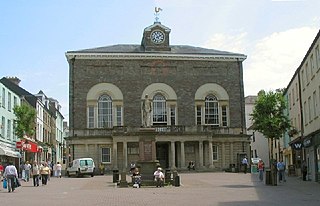
Sir Robert Taylor (1714–1788) was an English architect and sculptor who worked in London and the south of England.

The Middlesex Guildhall is an historic court building in Westminster which houses the Supreme Court of the United Kingdom and the Judicial Committee of the Privy Council. The building stands on the south-western corner of Parliament Square, near the Palace of Westminster. In 1970, the building was listed Grade II*.

Bishop Wordsworth's School is a Church of England boys' grammar school in Salisbury, Wiltshire for boys aged 11 to 18. The school is regularly amongst the top-performing schools in England, and in 2010 was the school with the best results in the English Baccalaureate. It was granted academy status in March 2011 and is an Additional Member of the Headmasters' and Headmistresses' Conference. It is within the grounds of Salisbury Cathedral, adjacent to the Cathedral School.

Salisbury is a constituency represented in the House of Commons of the UK Parliament since 2010 by John Glen of the Conservative Party.

Winterslow is a civil parish with a population of around 2,000, about 6 miles (10 km) northeast of Salisbury in Wiltshire, England, and lying south of the A30 London Road. It is sited on the Roman road between Old Sarum and Winchester.
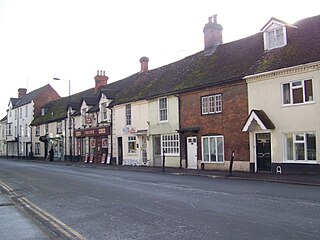
Wilton is a town and civil parish in Wiltshire, England. Lying about 3 miles (5 km) west of the city of Salisbury, and until 1889 the county town of Wiltshire, it has a rich heritage dating back to the Anglo-Saxons.
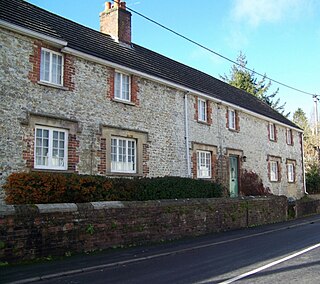
Bishopstrow is a small village and civil parish in Wiltshire, England, on the southeastern edge of the town of Warminster. The village is about 1.5 miles (2.4 km) from the town centre, south of the old Warminster to Salisbury road, formerly the A36, now the B3414.
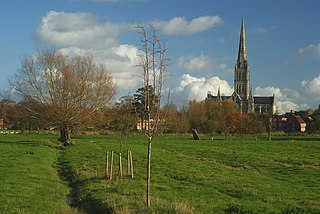
Harnham is a suburb of the city of Salisbury in Wiltshire, England, centred about 0.6 miles (1 km) south of Salisbury Cathedral and across the River Avon. Harnham is split into the areas of West Harnham and East Harnham.

Britford is a village and civil parish beside the River Avon about 1.5 miles (2.4 km) south-east of Salisbury in Wiltshire, England. The village is just off the A338 Salisbury-Bournemouth road. The 2011 Census recorded a parish population of 592.

Wiltshire Council, known between 1889 and 2009 as Wiltshire County Council, is the local authority for the non-metropolitan county of Wiltshire in South West England. Since 2009 it has been a unitary authority, being a county council which also performs the functions of a district council. The non-metropolitan county is smaller than the ceremonial county, the latter additionally including Swindon. Wiltshire Council has been controlled by the Conservative Party since 2000, and has its headquarters at County Hall in Trowbridge.

Salisbury City Council is a parish-level council for Salisbury, England. It was established in April 2009 and is based in the city's historic Guildhall. Following the May 2021 election, no party has an overall majority.

The Guildhall is a historic building in Bore Street in Lichfield, Staffordshire in the United Kingdom. The guildhall is a Grade II listed building.

Netherhampton is a village and civil parish in Wiltshire, England, immediately west of the city of Salisbury. The village is about 2 miles (3.2 km) from the city centre.

Gloucester Shire Hall is a municipal building in Westgate Street, Gloucester. The shire hall, which is the main office and the meeting place of Gloucestershire County Council, is a grade II listed building.
Francis Lear was Dean of Salisbury in the Church of England from 1846 until his death.
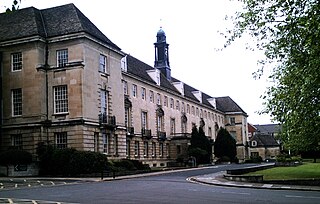
County Hall is a municipal building in Bythesea Road, Trowbridge, Wiltshire, England, completed in 1940. It is the headquarters of Wiltshire Council.
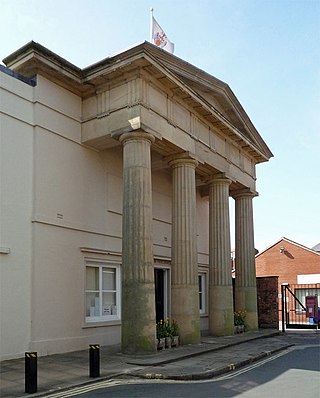
The Guildhall is a municipal facility at Register Square in Beverley, East Riding of Yorkshire, England. It is a Grade I listed building.

The Old Town Hall is a municipal building in the Market Place in Wilton, Wiltshire, England. The structure, which is currently used as a Baptist church, is a Grade II listed building.



















